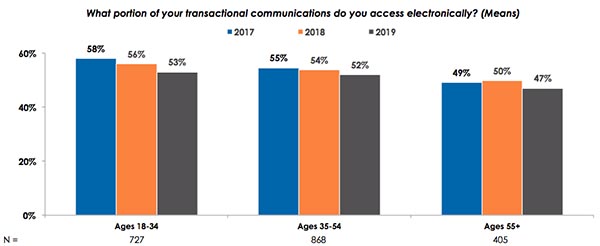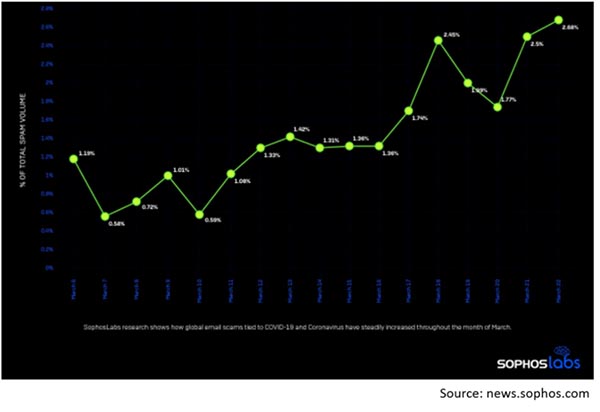- Channel Fog is the uncertainty consumers have surrounding the task of determining which communication channels to use in today’s multi-channel world.
- Channel Fatigue refers to the mounting difficulty associated with managing massive amounts of digital data from an ever-widening pool of consumer and business information.
- The exponential acceleration of channel fog and fatigue (particularly in the digital realm) have created a significant burden for consumers.
By Marc Mascara
Introduction
In the latter half of 2019, Keypoint Intelligence (KPI) identified an emerging trend in the consumer space that affected the areas of transactional and marketing communications. Contrary to many assumptions and preconceived notions, the share of transactional communications that consumers accessed electronically declined steadily over the past three years. Data from our Annual State of Transactional Communications consumer survey uncovered a 5% year-over-year drop in this share. It is also interesting to note that the share of respondents between the ages of 18 and 34 who accessed their transactional communications electronically declined even faster than the other age groups.
Share of Transactional Communications Accessed Electronically

Base: Total Consumer Respondents in the U.S. and Canada
Source: Annual State of Transactional Communications Consumer Surveys, Keypoint Intelligence
Although younger consumers do access a greater share of their communication electronically, this share has not increased as originally expected. Regarding paper-only and both digital and paper preferences, the year-over-year trend was an increase of about 2% to 3%. This suggests that digital as well as printed channels are both flattening. Print is no longer falling off the cliff, but digital communications are not on a steep growth trajectory either.
Channel Fog vs. Channel Fatigue
To better understand this change in consumer channel preferences, we performed a deeper analysis of our survey data and uncovered two phenomena that we call “channel fog” and “channel fatigue.” These forces are defined as follows:
- Channel Fog is the uncertainty consumers have surrounding the task of determining which communication channels to use in today’s multi-channel world. Concerns about the security of personal data, near-constant media reports of fraud and identity theft, and personal experience with digital channels being hacked are the primary contributors to channel fog.
- Channel Fatigue refers to the mounting difficulty associated with managing massive amounts of digital data from an ever-widening pool of consumer and business information. This fatigue is driven by the overwhelming amount of communications that can come from a single channel, as well as the day-to-day maintenance of multiple accounts and passwords.
Brands and enterprises are beginning to understand that when it comes to communication channels, consumer preference is paramount. Businesses that ignored customer preferences about how they wanted to be communicated with saw a decline in loyalty and increased attrition. Mounting channel fog and fatigue have only contributed to these trends.
In response to COVID-19, some businesses might be tempted to accelerate the transition to paperless by making the paperless option a default or even make it the only option. Although this practice might seem beneficial when a global pandemic is putting a spotlight on digital communications, KPI’s most recent transactional communications study shows that this may not be the best long-term strategy. Over three-quarters of consumers in North America agreed that they wanted to decide which channels their providers used to communicate with them, and nearly half (47%) wanted printed versions of their bills and statements. In addition, 64% of respondents agreed that when they switched from one provider to another, it was often due to a bad experience—like a disregard of customer communication preferences!
COVID-19: The Great Accelerator
For enterprises and brand owners, the presence of a captive audience and a means to broaden digital communication channels are viewed as positives. On the consumer side, however, the exponential acceleration of channel fog and fatigue (particularly in the digital realm) have created a significant burden. According to Sophos, e-mails mentioning COVID-19 and coronavirus already accounted for a significant share of spam traffic by early March. In some cases, these scam communications included calls to action like “you have an email about your credit” or “you have received a fax about your loan.”
COVID-19 and Coronavirus Scams Are on the Rise

In March 2020, the Canadian Radio-Television and Telecommunications Commission issued a call for comments to consumers about the provision of paper bills by communication service providers. Many service providers are at least considering a transition from paper to electronic billing, and the Commission is tasked with determining whether intervention is warranted regarding the billing practices of transactional communication providers and what steps should be taken to meet the needs of consumers. Some Canadians expressed concerns about service providers transitioning from paper billing to e-billing, so this proposed shift might not be well-received.
Back in May, we were about two months into the pandemic in the United States. KPI’s Annual State of Marketing Communications Consumer Surveys (North America and Europe) had just exited the field, and results from this research indicated that the share of consumers who prefer email for marketing communications is roughly the same as that for direct mail. Since that time, KPI has fielded additional research on transactional communications that will shed more light on consumers’ changing preferences. Preliminary analysis suggests an acceleration of omni-channel communications, including printed messaging from a familiar and trusted sender and digital messaging to facilitate execution of the action. More information on this comprehensive research can be obtained by emailing [email protected].
The Bottom Line
Although many predicted the demise of print due to increasingly widespread digital communications, research from KPI’s Customer Communications Service suggests otherwise. In fact, the COVID-19 pandemic will likely only serve to accelerate consumers’ demands for providers that communicate with them via their desired channels. Print service providers and customer communication solution providers will likely feel the effects of this acceleration, which will fuel an ever-greater need for omni-channel communications. Enterprises and brand owners will also need to increase their artificial intelligence capabilities to accommodate the need for personalized, relevant content from printed as well as digital communications.
Marc Mascara is the Director of Keypoint Intelligence’s Customer Communications Advisory Service. In this role, he supports customers with strategic go-to-market advice related to customer communications. Marc’s responsibilities include conducting market research and analysis, consulting engagements, forecasting market growth, managing client care, and providing coverage of industry events.















Discussion
Only verified members can comment.